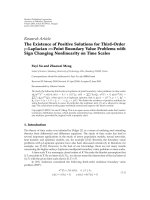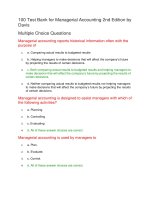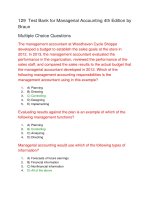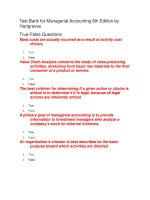The controllers function the work OF the managerial accountant third edition by janice m roehl anderson and steven m bragg
Bạn đang xem bản rút gọn của tài liệu. Xem và tải ngay bản đầy đủ của tài liệu tại đây (13.19 MB, 480 trang )
THE CONTROLLER’S
FUNCTION
THE WORK OF THE MANAGERIAL
ACCOUNTANT
THIRD EDITION
JANICE M. ROEHL-ANDERSON
STEVEN M. BRAGG
JOHN WILEY & SONS, INC.
THE CONTROLLER’S
FUNCTION
THE WORK OF THE MANAGERIAL
ACCOUNTANT
THE CONTROLLER’S
FUNCTION
THE WORK OF THE MANAGERIAL
ACCOUNTANT
THIRD EDITION
JANICE M. ROEHL-ANDERSON
STEVEN M. BRAGG
JOHN WILEY & SONS, INC.
This book is printed on acid-free paper.
Copyright © 2005 by John Wiley & Sons, Inc. All rights reserved.
Published by John Wiley & Sons, Inc., Hoboken, New Jersey
Published simultaneously in Canada
No part of this publication may be reproduced, stored in a retrieval system, or transmitted in any
form or by any means, electronic, mechanical, photocopying, recording, scanning, or otherwise,
except as permitted under Section 107 or 108 of the 1976 United States Copyright Act, without
either the prior written permission of the publisher or authorization through payment of the appropriate per-copy fee to the Copyright Clearance Center, Inc., 222 Rosewood Drive, Danvers, MA
01923, 978-750-8400, fax 978-646-8600, or on the web at www.copyright.com. Requests to the
publisher for permission should be addressed to the Permissions Department, John Wiley & Sons,
Inc., 111 River Street, Hoboken, NJ 07030, 201-748-6011, fax 201-748-6008.
Limit of Liability/Disclaimer of Warranty: While the publisher and author have used their best
efforts in preparing this book, they make no representations or warranties with respect to the accuracy or completeness of the contents of this book and specifically disclaim any implied warranties
of merchantability or fitness for a particular purpose. No warranty may be created or extended by
sales representatives or written sales materials. The advice and strategies contained herein may not
be suitable for your situation. You should consult with a professional where appropriate. Neither the
publisher nor author shall be liable for any loss of profit or any other commercial damages, including but not limited to special, incidental, consequential, or other damages.
For general information on our other products and services, or technical support, please contact our
Customer Care Department within the United States at 800-762-2974, outside the United States at
317-572-3993 or fax 317-572-4002.
Wiley also publishes its books in a variety of electronic formats. Some content that appears in print
may not be available in electronic books.
For more information about Wiley products, visit our web site at www.wiley.com.
Library of Congress Cataloging-in-Publication Data
ISBN 0-471-68330-2
Printed in the United States of America
10 9 8 7 6 5 4 3 2 1
CONTENTS
Acknowledgments
About the Authors
Preface
xi
xiii
xv
1 The Controller’s Job
1
History of the Controller’s Function
Main Job Functions
Job Description
Job Qualifications
Organizational Structure of the Accounting Department
Ethics
2 Internal Control
1
2
3
6
7
10
12
Basic Elements
Controls to Use in Your Business
Elements of Internal Accounting Control
Levels of Controls
Responsibility for Proper Internal Controls
Fraud
Auditing for Fraud
3 Planning and the Strategic Plan
Strategic Plan Overview
System of Plans
Planning Cycle
Planning Roles
Planning Timing and the Planning Period
Business Mission
Developing Long-Range Objectives
Developing Long-Range Strategies
v
12
19
54
55
56
57
61
63
63
65
66
69
70
71
73
75
vi
Contents
4 Long-Range Financial Plan
Layout and Purpose
Trends of Revenues and Profits
Capital Investments
Cash Flows and Financing Requirements
Risk Analysis
Breakdown by Business Unit/Product Line/Geography
Financial Position
5 Annual Plan
System of Plans
Annual Planning Cycle
Role of the Controller
Sales Planning: The Base of All Business Plans
Steps in Developing the Near-Term Sales Plan
Methods for Determining the Sales Forecast
Useful Sources for Forecasting Information
Break-Even Chart
Changes in the Sales Mixture
Changes in the Sales Price
Changes in the Cost
6 Sales
79
79
80
81
83
85
86
87
93
93
104
105
106
106
108
112
112
115
117
117
119
Role of the Controller
Sales Analysis
Sales Standards
Sales Reports
Product Pricing
119
121
124
127
129
7 Distribution Expenses
135
Role of the Sales Manager
Analyzing Distribution Costs
Analyzing by Application
Setting the Distribution Budget
8 Direct Materials and Labor
Objectives
Role of the Controller
Types of Cost Systems
Measuring Direct Material Costs
Controlling Direct Material Costs
Controlling Direct Material Quantities
Measuring Direct Labor Costs
136
136
138
144
151
151
152
155
156
157
159
162
Contents
Controlling Direct Labor Costs
Target Costing
9 Overhead
Need for Overhead Controls
Responsibilities of the Controller
Account Classifications
Fixed and Variable Costs
Cost Allocation
Controlling Overhead
Production Reports
10 General and Administrative Expenses
Functions Involved
Accounting for and Allocating Administrative Expenses
“Unique” Expenses
Controlling Costs
11 Cash and Investments
Objectives of Cash Management
Role of the Controller
Cash Collections
Cash Disbursements
Investment of Short-Term Funds
Accounting for Records of Investment
Cash and Investment Controls
12 Receivables
Functions of the Credit Department
Shortening the Receivables Cycle
Reserve for Doubtful Accounts
Receivables Fraud and Control
13 Inventory
vii
162
169
171
172
172
174
176
181
190
193
196
196
197
199
201
204
204
205
205
206
207
210
213
219
219
222
224
225
227
Inventory Management Systems
Inventory Tracking
Physical Inventory Procedure
Inventory Valuation
Inventory Fraud and Controls
227
233
239
242
246
14 Property, Plant, and Equipment
249
Role of the Controller
Capital Budgeting
Postproject Appraisals
Other Aspects of Fixed Assets
250
251
261
262
viii
Contents
15 Liabilities
Objectives
Controls
Credit Agreement Provisions
Debt Capacity
Bond Ratings
Leverage
16 Equity
Role of the Controller
Cost of Capital
Dividend Policy
Long-Term Equity Planning
Repurchasing Common Shares
Capital Stock Records
17 Operational Accounting
Create Departmental Job Descriptions
Create a Departmental Training Program
Clear Out Excess Documentation
Document All Major Processes
Schedule the Department
Correct the Underlying Causes of Errors
Use of Best Practices
Outsourcing Selected Accounting Functions
18 Closing Procedures
Selecting the Fiscal Year
Selecting Interim Reporting Periods
Quick Close
19 Performance Measurements and Trends
Performance Measurements
Trends
Interrelationship of Ratios
Just-in-Time Ratios
20 Financial Analysis
Analyzing Financial Statements
Analyzing Working Capital
Analyzing Capital Investments
Analyzing Capacity Utilization
Analyzing Financing Options
266
266
267
268
269
271
272
274
274
275
283
284
289
290
292
292
294
296
297
297
299
301
304
309
309
310
311
319
320
335
336
337
340
340
345
351
353
356
Contents
Creating Forecasts
Improving Shareholder Value
21 Taxes
Tax Strategy
Tax Organization
Role of the Tax Manager
Tax Records
Tax versus Book Accounting
Proper Classification of Accounts
ix
358
360
366
367
368
370
371
374
375
22 Selecting a Financial Information System
376
Reasons to Purchase Software
Defining Systems Requirements
Existing System Documentation
Joint Sessions
Preparing the Request for Proposal
Distribution of the Request for Proposal
Review of the Vendor’s Completed Proposal
Reference Calls
Demonstration
Site Visits
Cost of the System
Final Selection
Contract Negotiations
Postimplementation Review
376
377
380
381
383
388
389
392
394
394
395
395
396
397
23 Project Risk Management
Project Risk Categories
Project Risk Management Approach
24 Implementing a Successful CRM Solution
Define a Business Case to Drive Shareholder Value
Clearly Communicate the Change Imperative
Building a Winning Team
Prepare for the Worst
25 Organizations Large and Small
Embrace Shared Services
Executive Summary
About the Survey
Business Case
Implementation
399
400
402
410
411
412
413
415
416
417
418
418
421
x
Contents
Operations
Customer Relations
Next Steps
26 Information Technology Offshore and Outsourcing
What Offshoring Is
Providers’ Approach to Outsourcing and Offshoring
Variants: Build, Buy, Rent
Popular Start-Up Options
How Offshoring Is Different from Engaging
a Local Service Provider
Ensuring That Risks and Rewards Are Balanced
Deciding if Offshoring Is Good for a Company
27 Change Management
Implementation History
Competing Projects
Degree of Disruption
Cost of Failure
Risks
423
424
426
428
428
432
432
433
434
435
436
437
438
440
442
442
443
App A New Controller Checklist
450
Index
455
ACKNOWLEDGMENTS
With the rapidly changing business environment, it is essential that the
material contained in this revision be accurate, up-to-date, and relevant.
Accordingly, in addition to the chapters written or revised by the coauthors,
these contributing authors, listed alphabetically, wrote or revised the chapters indicated:
Kevin Church, Senior Manager
Deloitte Consulting, San Francisco, California
Chapter 25, “Organizations Large and Small Embrace Shared Services”
Pak Fong, Senior Manager
Deloitte Consulting, San Francisco, California
Chapter 24, “Implementing a Successful CRM Solution”
Susan Hogan, Principal
Deloitte Consulting, Atlanta, Georgia
Chapter 25, “Organizations Large and Small Embrace Shared Services”
Sara J. Moulton-Reger, e-Business Strategy Consultant
IBM Global Services, Denver, Colorado
Chapter 23, “Project Risk Management”
Chapter 27, “Change Management”
Kalyana Sundaram, Senior Manager
Deloitte Consulting LLP
Chapter 26, “Information Technology Offshore and Outsourcing”
Jan Roehl-Anderson would like to thank God for His unending blessings.
Additionally, thanks should be given to Fritz Anderson for his patience and
moral support.
A special note of thanks to our editor, Sheck Cho, not only for suggesting
the original edition, but also for suggesting a revised and enlarged version.
xi
ABOUT THE AUTHORS
Janice M. Roehl-Anderson, MBA, is a partner with Deloitte Consulting
LLP, with over 20 years of consulting experience. She specializes in information systems security; financial and cost accounting system analysis,
design, selection, and implementation; and long-range information system
planning. She has also worked for Ernst & Young and has successfully
completed the CPA exam.
Steven M. Bragg, CPA, CMA, CIA, CPIM, has been the chief financial
officer or controller of four companies, as well as a consulting manager at
Ernst & Young and auditor at Deloitte & Touche. He received a master’s
degree in Finance from Bentley College, an MBA from Babson College,
and a bachelor’s degree in Economics from the University of Maine. He
has been the two-time president of the 10,000-member Colorado Mountain
Club and is an avid alpine skier, mountain biker, and rescue diver. He has
also written Just-in-Time Accounting, Advanced Accounting Systems, Outsourcing, Accounting Best Practices, Cost Accounting, Financial Analysis,
Inventory Best Practices, Payroll Accounting, and Managing Explosive
Corporate Growth, and has coauthored Controllership: The Work of the
Managerial Accountant. Mr. Bragg resides in Centennial, Colorado.
xiii
PREFACE
This revised edition of The Controller’s Function is a complete operations
reference manual for the corporate controller. Within these pages the reader
will find a comprehensive discussion of how to manage all major aspects of
the controller’s job, including strategic and annual planning, financial
reporting, and managing all aspects of the accounting department, as well
as peripheral issues such as the fast close, electronic data interchange, best
practices, a wide array of controls to help deal with the Sarbanes-Oxley
Act, software selection and implementation, and financial analysis—and
much, much more.
This book was written in response to the growing realization that the
controller is no longer being called on just to process accounting transactions and issue financial statements, tasks requiring detailed technical
knowledge but no considerable management or analysis skill. Instead, the
modern controller must exhibit additional mastery of a multitude of management skills, so that the accounting department runs in an efficient and
effective manner, offers a detailed analysis of financial statement results,
recommends improvements, and monitors the activities of other departments and perhaps even manages the computer systems in a smaller organization. This book gives considerable attention to the most recent advances
in all these new areas of responsibility, so that the controller will be fully
capable of installing and using them to improve his or her company’s level
of competitive advantage. Included in our coverage of these advances are
the use of electronic spreadsheets for financial analysis, shared services
computing applications, target costing, disaster recovery planning, activitybased costing, outsourcing, information systems security, and software
package integration.
In addition to these more advanced categories, the book also includes
such bread-and-butter topics as cash management, internal control systems
and fraud prevention, accounts receivable collections, inventory valuation,
xv
xvi
Preface
budgeting, taxes, insurance, and capital budgeting. Because basic and
advanced accounting management topics are combined in one volume, the
reader has access to the complete reference for mastering the controller’s
function.
Centennial, Colorado
November 2004
THE CONTROLLER’S
FUNCTION
THE WORK OF THE MANAGERIAL
ACCOUNTANT
1
THE CONTROLLER’S JOB
Today’s corporation operates in an increasingly complex environment,
where there are far too many activities for a chief executive officer (CEO)
to keep track of. To an increasing degree, this monitoring function falls on
the shoulders of the controller, who must keep the CEO apprised of the performance of all departments, product sales, costs and profits, control issues
in a variety of transaction processing systems, and the impact of new government taxes and other regulations on the conduct of the business. Thus,
the controller can reasonably be compared to the ship’s navigator, who
warns the captain of current or foreseeable problems in the shoals of the
business environment that lie ahead and on all sides. In this chapter, we
explore the main functions of the controller, how they have changed over
time, what kind of background a controller should have, and the role of ethics in the conduct of the job.
HISTORY OF THE CONTROLLER’S FUNCTION
The controller was originally nothing more than a bookkeeper. This person’s
role was to accurately record all transactions passing through the accounting
department, transactions primarily related to the payment of suppliers, the
billing of customers, and/or the handling of cash. The controller was also
required to issue periodic financial statements, which were just that—no
supporting footnotes, executive summaries, or other types of analysis were
expected or required. The traditional career path leading to this position was
through the clerical ranks, so that the person in the controller’s job was intimately familiar with how to manage the transaction flow and could be relied
on to keep the same old systems running forever.
1
2
The Controller’s Job
The function changed with the advent of computers, since accounting
was one of the first company departments to adopt automation. The controller was now required to have more than a passing knowledge of computer systems, including how to select, install, and operate them. The
controller even became the manager of the management information systems (MIS) department for many smaller companies, since the accounting
department was the main beneficiary of computers. This was also a distinctly different job requirement, which led to the hiring of more collegelevel people into the position. By doing so, many companies sidestepped
the traditional advancement method that no longer yielded controllers with
a die-hard attitude toward maintaining the old accounting systems. Instead,
now controllers were willing to modify their systems to make the best use
of the new computer software, which brought about some improvements in
departmental efficiency.
In the 1970s and 1980s, CEOs became more concerned with the efficiency of all company departments, including the accounting function.
Supported by the efforts of many consulting gurus, such as Michael Hammer (author of Reengineering the Corporation), increasing pressure came
to bear on controllers to find new ways to run their departments in order to
wring out all possible inefficiencies. This trend forced out many old-line
controllers who were uncomfortable with new systems, but brought in a
new breed of heavily educated controllers, many of them with advanced
educations and consulting experience, who streamlined many transactional
systems and began to reach outside of the accounting department to other
areas of the company to provide a profit center and other specialized forms
of financial analysis.
Since the turn of the century, the focus has progressed along the same
trend line we saw established in the last two decades, which is for the controller to manage the accounting department’s costs and efficiencies as
tightly as possible, while also using a great deal of process and financial
analysis skill to assist all parts of the corporation in many ways. Over the
course of one century, the controller’s function has risen from one of senior
clerk to one of the most advanced, highly educated, and useful positions in
the entire corporate structure.
MAIN JOB FUNCTIONS
The controller has a number of distinct job functions. The first four are
ones that can be ascribed to any manager in any department. The last two
Job Description
3
are more specialized, and do not refer to management skill. The six functions are:
1. Planning. The controller is responsible for determining who does
the work, what work is to be done, and the timing of work completion
in the accounting department, especially in regard to the timely processing of transactions and the issuance of accurate financial statements. This also extends to the budget, where the controller guides
the budgeting process through other departments.
2. Organizing. The controller is responsible for obtaining and keeping
the services of experienced and well-trained accounting personnel;
this is by far the most important organizational task. This also
involves obtaining sufficient floor space, office equipment, and computer hardware and software to complete all assigned work.
3. Directing. The controller is responsible for ensuring that all employees
in the department work together in an orderly manner to achieve the controller’s plans.
4. Measuring. The controller is responsible for measuring the performance of all key aspects of the department to ensure that performance
matches or exceeds standards and that errors are caught and corrected.
5. Financial analysis. The controller is responsible for the review,
interpretation, and generation of recommendations related to corporate financial performance. This requires excellent communication
skills (both written and oral), so that the controller’s information is
properly and effectively conveyed to the other members of the management team.
6. Process analysis. The controller is responsible for periodically
reviewing and evaluating the performance of each major process that
is involved in the completion of transactions, with the dual (and sometimes conflicting) objectives of maintaining tight financial controls
over processes while also running them in a cost-effective and efficient manner.
The successful controller in years past would be concerned only with the
first four of these job functions; the recent expansion of the controller’s job
description calls for the addition of the last two items.
JOB DESCRIPTION
The controller has one of the most complex job descriptions of all company managers, because there are so many functional areas for which he or
4
The Controller’s Job
she is responsible. This section provides a detailed job description that is
sorted by general category in alphabetical order. The controller’s responsibilities are:
Auditing
• The scheduling and management of periodic internal audits, as well
as the preparation of resulting audit reports and the communication of
findings and recommendations to management and the board of
directors.
• The preparation of work papers for the external auditors and the rendering of any additional assistance needed by them to complete the
annual audit.
Budgeting
• The coordination of the annual budgeting process, including maintenance of the company budget, and the transfer of final budget information into the financial statements.
Control Systems
• The establishment of a sufficiently broad set of controls to give management assurance that transactions are processed properly.
Cost Accounting
• The coordination of periodic physical inventory counts.
• The periodic analysis and allocation of costs based on activity-based
costing pools and allocation methods.
• The continual cost review of products currently under development,
using the principles of target costing.
• The periodic compilation and evaluation of inventory costs.
Financial Analysis
• The periodic comparison of actual to budgeted results and the communication of variances to management, along with recommendations for
improvement.
• The continuing review of revenue and expense trends and the communication of adverse trend results to management, along with recommendations for improvement.
Job Description
5
• The periodic compilation of business cycle forecasting statistics and
the communication of this information to management, along with predictions related to the impact on company operations.
• The periodic calculation of a standard set of ratios for corporate financial performance and the formulation of management recommendations based on the results.
Financial Statements
• The preparation of all periodic financial statements, as well as their
accompanying footnotes.
• The preparation of an interpretive analysis of the financial statements.
• The preparation and distribution of recurring and one-time management
reports.
Fixed Assets
• The annual audit of fixed assets to ensure that all recorded assets are
present.
• The periodic recording of fixed assets in the financial records and their
proper recording under the correct asset categories and depreciation
methods.
• The proper analysis of all capital expenditure requests.
Policies and Procedures
• The creation and maintenance of all policies and procedures related to
the control of company assets and the proper completion of financial
transactions.
• The training of department personnel in the use of accounting policies
and procedures.
• The modification of existing policies and procedures to match the
requirements of government regulations.
Process Analysis
• The periodic review of all processes involving financial analysis, to see
if they can be completed with better controls, lower costs, or greater
speed.









